Evaluating Stakeholder Engagement in Healthcare Projects
VerifiedAdded on 2020/05/08
|18
|3559
|284
AI Summary
The assignment explores the intersection of healthcare management and policy through a detailed analysis of stakeholder impact on youth mental health services. It references innovative services such as headspace in Australia to illustrate successful youth mental health strategies. The document analyzes how stakeholders contribute to shaping service delivery, utilizing concepts from UML diagrams like use case and activity diagrams for predictive insights. Moreover, it discusses methodologies including process mining for business process analysis in healthcare environments. By integrating economic evaluation methods and stakeholder engagement frameworks, the assignment provides a comprehensive view of developing sustainable and effective mental health services for young populations. The literature cited offers various perspectives on stakeholder identification, engagement, and their role in enhancing service delivery outcomes.
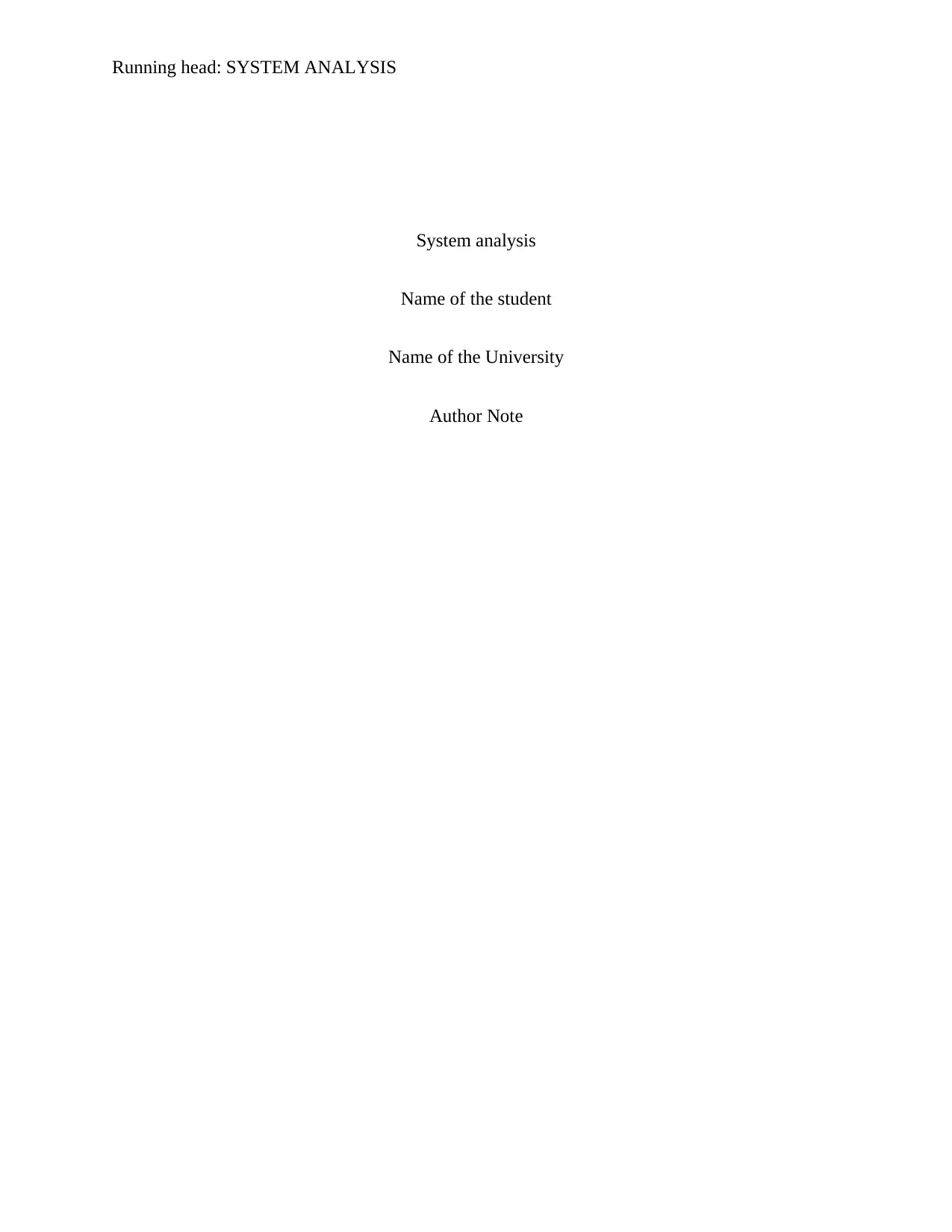
Running head: SYSTEM ANALYSIS
System analysis
Name of the student
Name of the University
Author Note
System analysis
Name of the student
Name of the University
Author Note
Paraphrase This Document
Need a fresh take? Get an instant paraphrase of this document with our AI Paraphraser
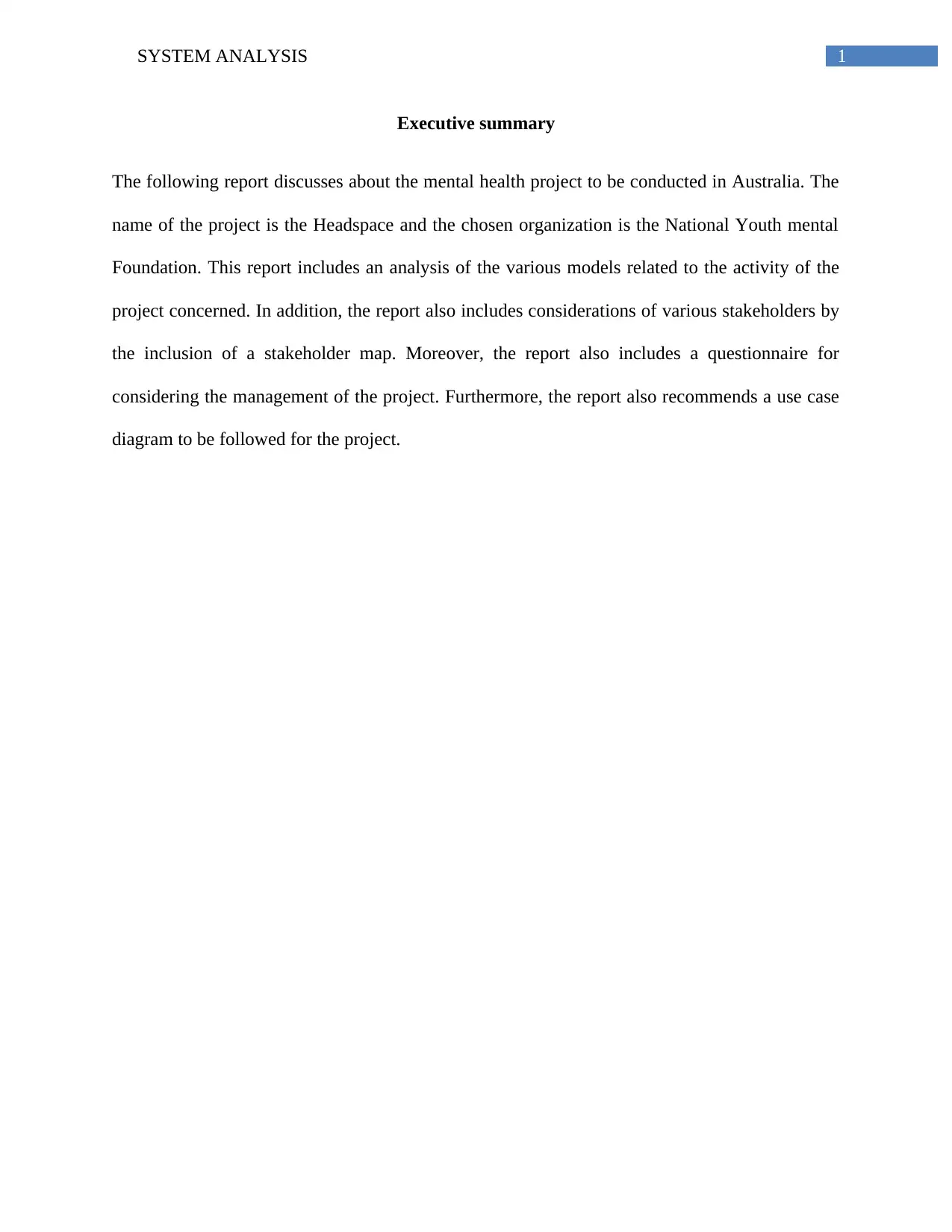
1SYSTEM ANALYSIS
Executive summary
The following report discusses about the mental health project to be conducted in Australia. The
name of the project is the Headspace and the chosen organization is the National Youth mental
Foundation. This report includes an analysis of the various models related to the activity of the
project concerned. In addition, the report also includes considerations of various stakeholders by
the inclusion of a stakeholder map. Moreover, the report also includes a questionnaire for
considering the management of the project. Furthermore, the report also recommends a use case
diagram to be followed for the project.
Executive summary
The following report discusses about the mental health project to be conducted in Australia. The
name of the project is the Headspace and the chosen organization is the National Youth mental
Foundation. This report includes an analysis of the various models related to the activity of the
project concerned. In addition, the report also includes considerations of various stakeholders by
the inclusion of a stakeholder map. Moreover, the report also includes a questionnaire for
considering the management of the project. Furthermore, the report also recommends a use case
diagram to be followed for the project.
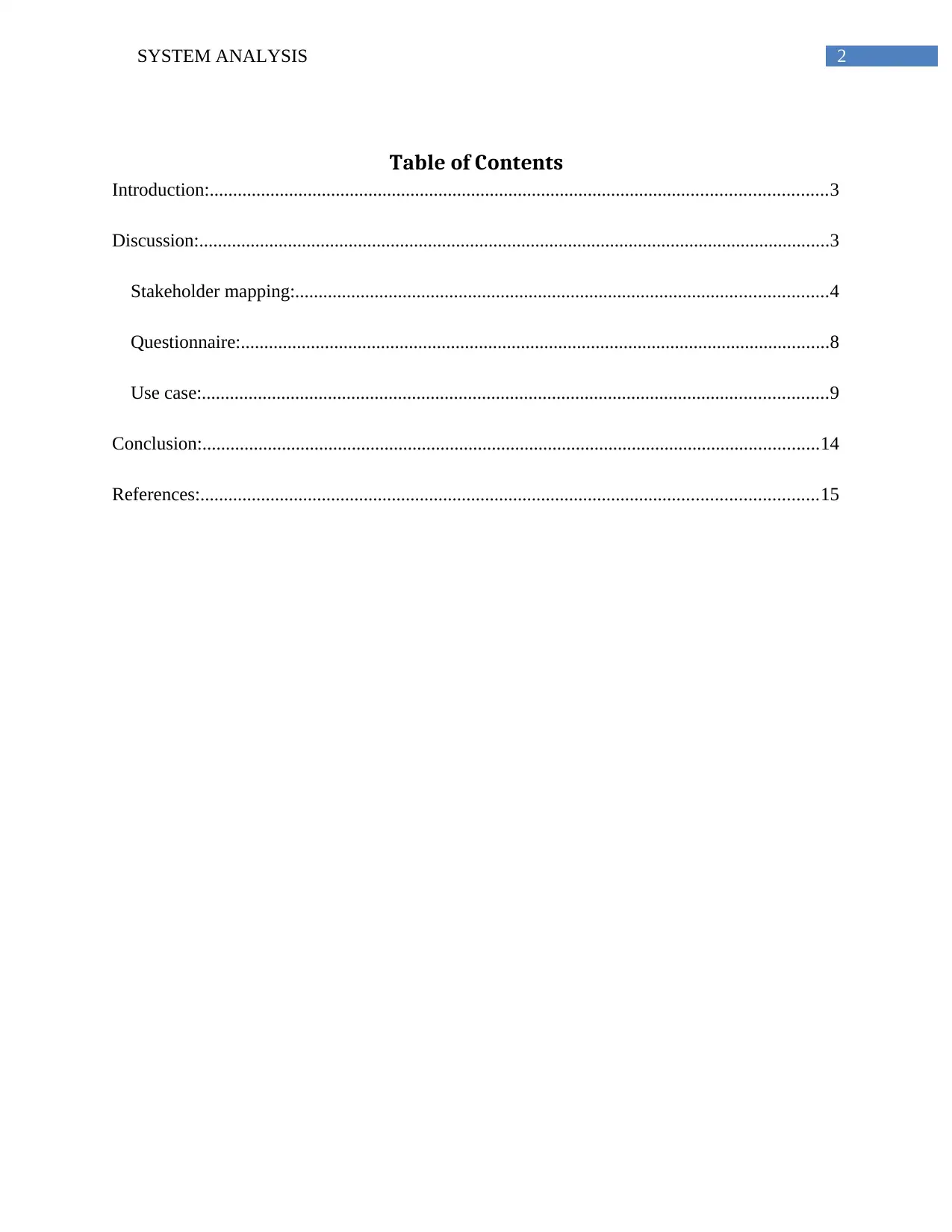
2SYSTEM ANALYSIS
Table of Contents
Introduction:....................................................................................................................................3
Discussion:.......................................................................................................................................3
Stakeholder mapping:..................................................................................................................4
Questionnaire:..............................................................................................................................8
Use case:......................................................................................................................................9
Conclusion:....................................................................................................................................14
References:....................................................................................................................................15
Table of Contents
Introduction:....................................................................................................................................3
Discussion:.......................................................................................................................................3
Stakeholder mapping:..................................................................................................................4
Questionnaire:..............................................................................................................................8
Use case:......................................................................................................................................9
Conclusion:....................................................................................................................................14
References:....................................................................................................................................15
⊘ This is a preview!⊘
Do you want full access?
Subscribe today to unlock all pages.

Trusted by 1+ million students worldwide
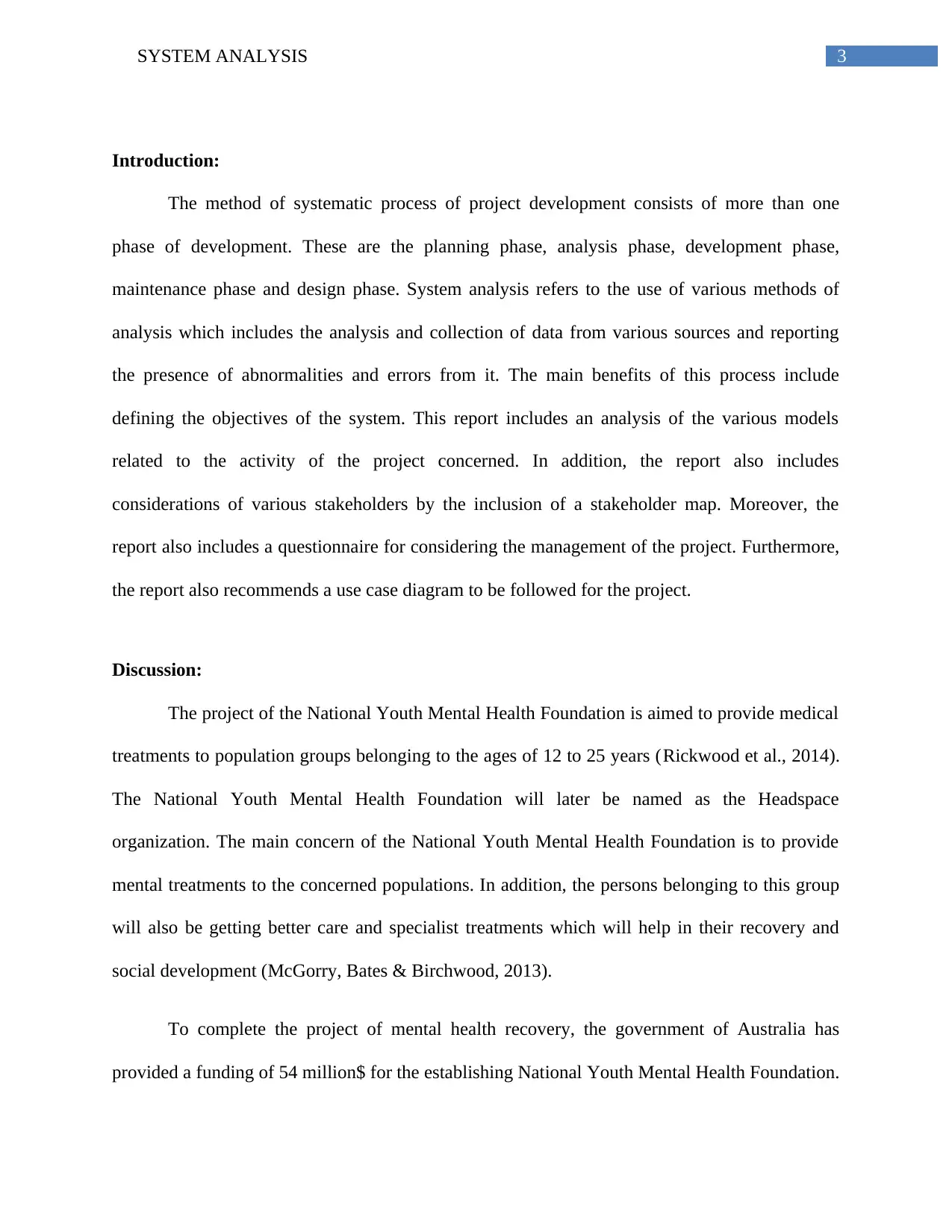
3SYSTEM ANALYSIS
Introduction:
The method of systematic process of project development consists of more than one
phase of development. These are the planning phase, analysis phase, development phase,
maintenance phase and design phase. System analysis refers to the use of various methods of
analysis which includes the analysis and collection of data from various sources and reporting
the presence of abnormalities and errors from it. The main benefits of this process include
defining the objectives of the system. This report includes an analysis of the various models
related to the activity of the project concerned. In addition, the report also includes
considerations of various stakeholders by the inclusion of a stakeholder map. Moreover, the
report also includes a questionnaire for considering the management of the project. Furthermore,
the report also recommends a use case diagram to be followed for the project.
Discussion:
The project of the National Youth Mental Health Foundation is aimed to provide medical
treatments to population groups belonging to the ages of 12 to 25 years (Rickwood et al., 2014).
The National Youth Mental Health Foundation will later be named as the Headspace
organization. The main concern of the National Youth Mental Health Foundation is to provide
mental treatments to the concerned populations. In addition, the persons belonging to this group
will also be getting better care and specialist treatments which will help in their recovery and
social development (McGorry, Bates & Birchwood, 2013).
To complete the project of mental health recovery, the government of Australia has
provided a funding of 54 million$ for the establishing National Youth Mental Health Foundation.
Introduction:
The method of systematic process of project development consists of more than one
phase of development. These are the planning phase, analysis phase, development phase,
maintenance phase and design phase. System analysis refers to the use of various methods of
analysis which includes the analysis and collection of data from various sources and reporting
the presence of abnormalities and errors from it. The main benefits of this process include
defining the objectives of the system. This report includes an analysis of the various models
related to the activity of the project concerned. In addition, the report also includes
considerations of various stakeholders by the inclusion of a stakeholder map. Moreover, the
report also includes a questionnaire for considering the management of the project. Furthermore,
the report also recommends a use case diagram to be followed for the project.
Discussion:
The project of the National Youth Mental Health Foundation is aimed to provide medical
treatments to population groups belonging to the ages of 12 to 25 years (Rickwood et al., 2014).
The National Youth Mental Health Foundation will later be named as the Headspace
organization. The main concern of the National Youth Mental Health Foundation is to provide
mental treatments to the concerned populations. In addition, the persons belonging to this group
will also be getting better care and specialist treatments which will help in their recovery and
social development (McGorry, Bates & Birchwood, 2013).
To complete the project of mental health recovery, the government of Australia has
provided a funding of 54 million$ for the establishing National Youth Mental Health Foundation.
Paraphrase This Document
Need a fresh take? Get an instant paraphrase of this document with our AI Paraphraser
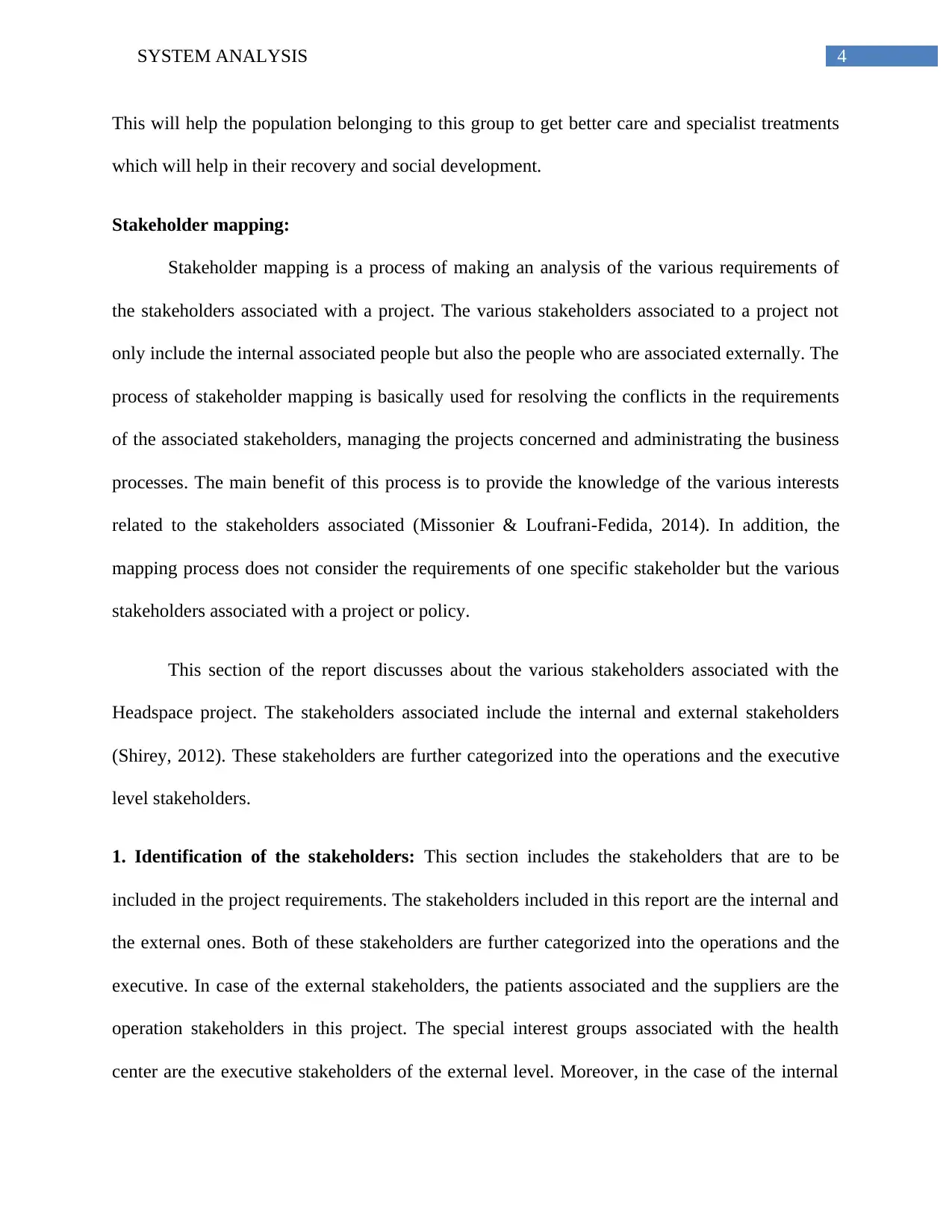
4SYSTEM ANALYSIS
This will help the population belonging to this group to get better care and specialist treatments
which will help in their recovery and social development.
Stakeholder mapping:
Stakeholder mapping is a process of making an analysis of the various requirements of
the stakeholders associated with a project. The various stakeholders associated to a project not
only include the internal associated people but also the people who are associated externally. The
process of stakeholder mapping is basically used for resolving the conflicts in the requirements
of the associated stakeholders, managing the projects concerned and administrating the business
processes. The main benefit of this process is to provide the knowledge of the various interests
related to the stakeholders associated (Missonier & Loufrani-Fedida, 2014). In addition, the
mapping process does not consider the requirements of one specific stakeholder but the various
stakeholders associated with a project or policy.
This section of the report discusses about the various stakeholders associated with the
Headspace project. The stakeholders associated include the internal and external stakeholders
(Shirey, 2012). These stakeholders are further categorized into the operations and the executive
level stakeholders.
1. Identification of the stakeholders: This section includes the stakeholders that are to be
included in the project requirements. The stakeholders included in this report are the internal and
the external ones. Both of these stakeholders are further categorized into the operations and the
executive. In case of the external stakeholders, the patients associated and the suppliers are the
operation stakeholders in this project. The special interest groups associated with the health
center are the executive stakeholders of the external level. Moreover, in the case of the internal
This will help the population belonging to this group to get better care and specialist treatments
which will help in their recovery and social development.
Stakeholder mapping:
Stakeholder mapping is a process of making an analysis of the various requirements of
the stakeholders associated with a project. The various stakeholders associated to a project not
only include the internal associated people but also the people who are associated externally. The
process of stakeholder mapping is basically used for resolving the conflicts in the requirements
of the associated stakeholders, managing the projects concerned and administrating the business
processes. The main benefit of this process is to provide the knowledge of the various interests
related to the stakeholders associated (Missonier & Loufrani-Fedida, 2014). In addition, the
mapping process does not consider the requirements of one specific stakeholder but the various
stakeholders associated with a project or policy.
This section of the report discusses about the various stakeholders associated with the
Headspace project. The stakeholders associated include the internal and external stakeholders
(Shirey, 2012). These stakeholders are further categorized into the operations and the executive
level stakeholders.
1. Identification of the stakeholders: This section includes the stakeholders that are to be
included in the project requirements. The stakeholders included in this report are the internal and
the external ones. Both of these stakeholders are further categorized into the operations and the
executive. In case of the external stakeholders, the patients associated and the suppliers are the
operation stakeholders in this project. The special interest groups associated with the health
center are the executive stakeholders of the external level. Moreover, in the case of the internal
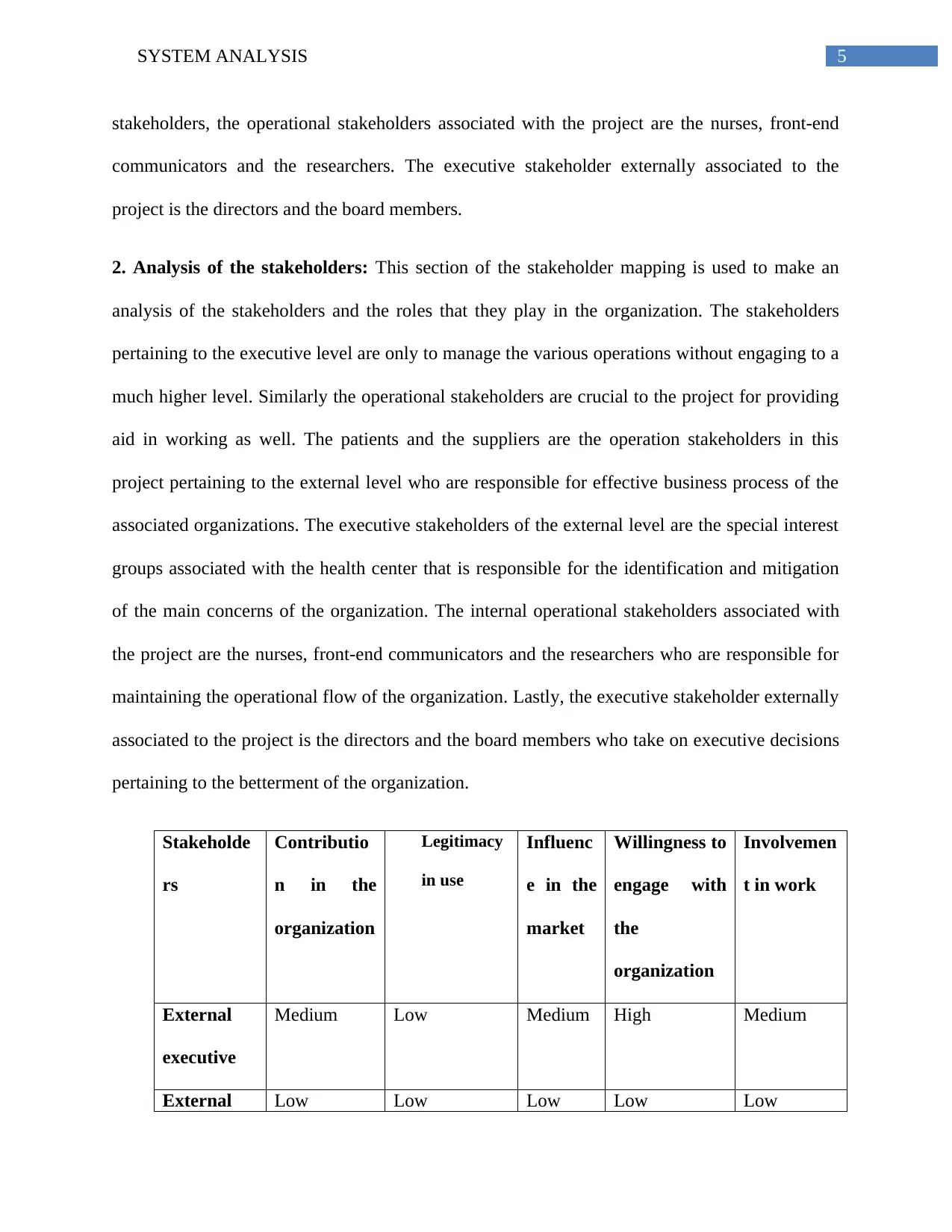
5SYSTEM ANALYSIS
stakeholders, the operational stakeholders associated with the project are the nurses, front-end
communicators and the researchers. The executive stakeholder externally associated to the
project is the directors and the board members.
2. Analysis of the stakeholders: This section of the stakeholder mapping is used to make an
analysis of the stakeholders and the roles that they play in the organization. The stakeholders
pertaining to the executive level are only to manage the various operations without engaging to a
much higher level. Similarly the operational stakeholders are crucial to the project for providing
aid in working as well. The patients and the suppliers are the operation stakeholders in this
project pertaining to the external level who are responsible for effective business process of the
associated organizations. The executive stakeholders of the external level are the special interest
groups associated with the health center that is responsible for the identification and mitigation
of the main concerns of the organization. The internal operational stakeholders associated with
the project are the nurses, front-end communicators and the researchers who are responsible for
maintaining the operational flow of the organization. Lastly, the executive stakeholder externally
associated to the project is the directors and the board members who take on executive decisions
pertaining to the betterment of the organization.
Stakeholde
rs
Contributio
n in the
organization
Legitimacy
in use
Influenc
e in the
market
Willingness to
engage with
the
organization
Involvemen
t in work
External
executive
Medium Low Medium High Medium
External Low Low Low Low Low
stakeholders, the operational stakeholders associated with the project are the nurses, front-end
communicators and the researchers. The executive stakeholder externally associated to the
project is the directors and the board members.
2. Analysis of the stakeholders: This section of the stakeholder mapping is used to make an
analysis of the stakeholders and the roles that they play in the organization. The stakeholders
pertaining to the executive level are only to manage the various operations without engaging to a
much higher level. Similarly the operational stakeholders are crucial to the project for providing
aid in working as well. The patients and the suppliers are the operation stakeholders in this
project pertaining to the external level who are responsible for effective business process of the
associated organizations. The executive stakeholders of the external level are the special interest
groups associated with the health center that is responsible for the identification and mitigation
of the main concerns of the organization. The internal operational stakeholders associated with
the project are the nurses, front-end communicators and the researchers who are responsible for
maintaining the operational flow of the organization. Lastly, the executive stakeholder externally
associated to the project is the directors and the board members who take on executive decisions
pertaining to the betterment of the organization.
Stakeholde
rs
Contributio
n in the
organization
Legitimacy
in use
Influenc
e in the
market
Willingness to
engage with
the
organization
Involvemen
t in work
External
executive
Medium Low Medium High Medium
External Low Low Low Low Low
⊘ This is a preview!⊘
Do you want full access?
Subscribe today to unlock all pages.

Trusted by 1+ million students worldwide
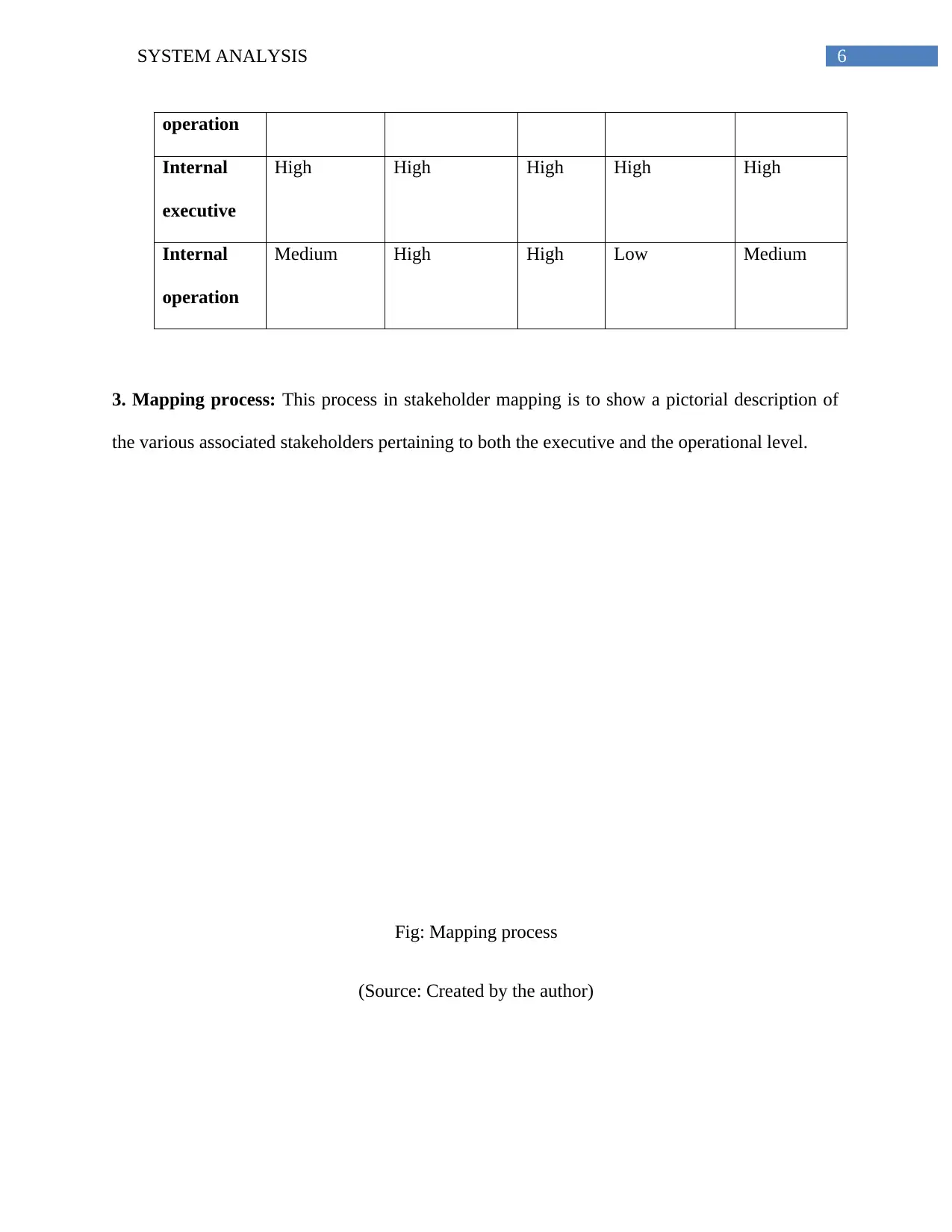
6SYSTEM ANALYSIS
operation
Internal
executive
High High High High High
Internal
operation
Medium High High Low Medium
3. Mapping process: This process in stakeholder mapping is to show a pictorial description of
the various associated stakeholders pertaining to both the executive and the operational level.
Fig: Mapping process
(Source: Created by the author)
operation
Internal
executive
High High High High High
Internal
operation
Medium High High Low Medium
3. Mapping process: This process in stakeholder mapping is to show a pictorial description of
the various associated stakeholders pertaining to both the executive and the operational level.
Fig: Mapping process
(Source: Created by the author)
Paraphrase This Document
Need a fresh take? Get an instant paraphrase of this document with our AI Paraphraser
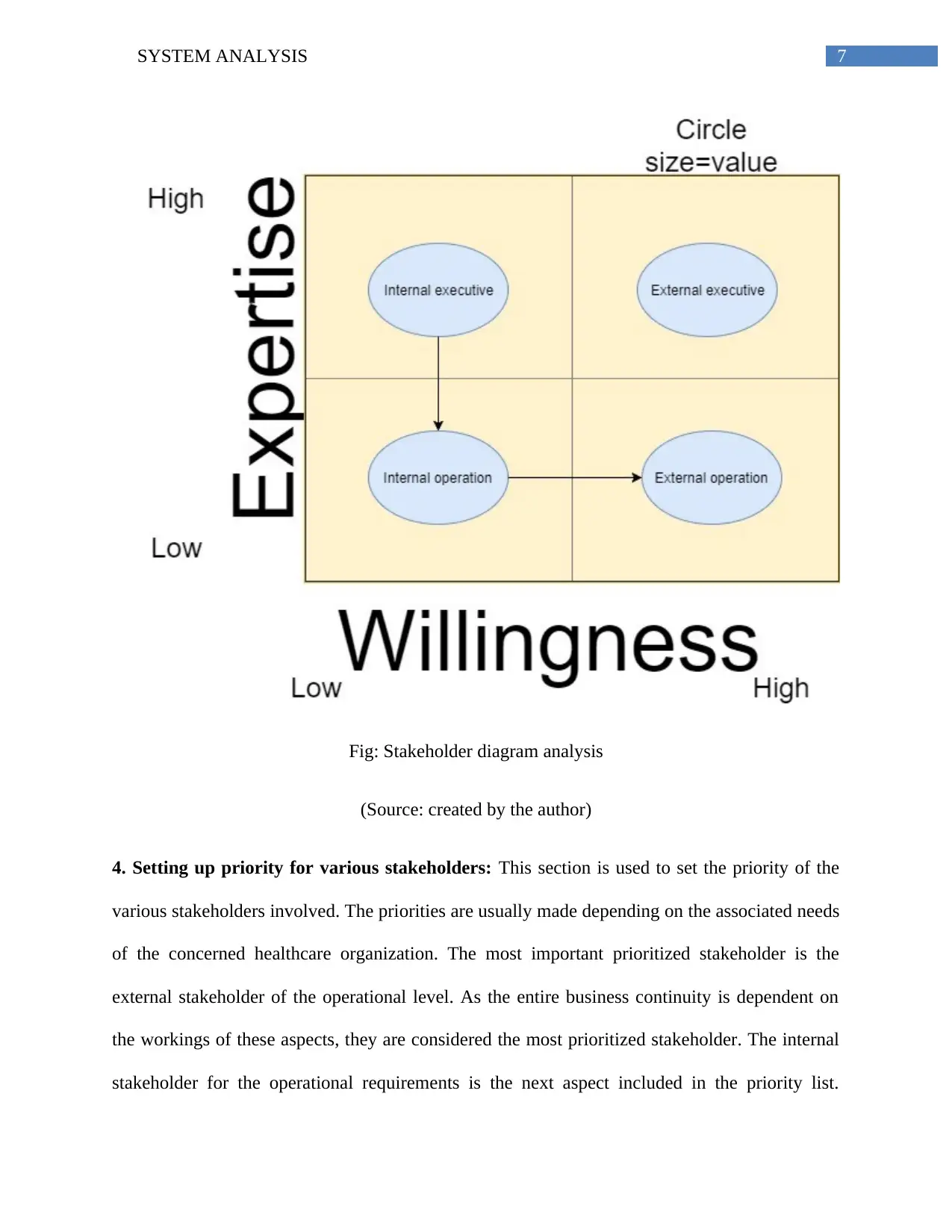
7SYSTEM ANALYSIS
Fig: Stakeholder diagram analysis
(Source: created by the author)
4. Setting up priority for various stakeholders: This section is used to set the priority of the
various stakeholders involved. The priorities are usually made depending on the associated needs
of the concerned healthcare organization. The most important prioritized stakeholder is the
external stakeholder of the operational level. As the entire business continuity is dependent on
the workings of these aspects, they are considered the most prioritized stakeholder. The internal
stakeholder for the operational requirements is the next aspect included in the priority list.
Fig: Stakeholder diagram analysis
(Source: created by the author)
4. Setting up priority for various stakeholders: This section is used to set the priority of the
various stakeholders involved. The priorities are usually made depending on the associated needs
of the concerned healthcare organization. The most important prioritized stakeholder is the
external stakeholder of the operational level. As the entire business continuity is dependent on
the workings of these aspects, they are considered the most prioritized stakeholder. The internal
stakeholder for the operational requirements is the next aspect included in the priority list.
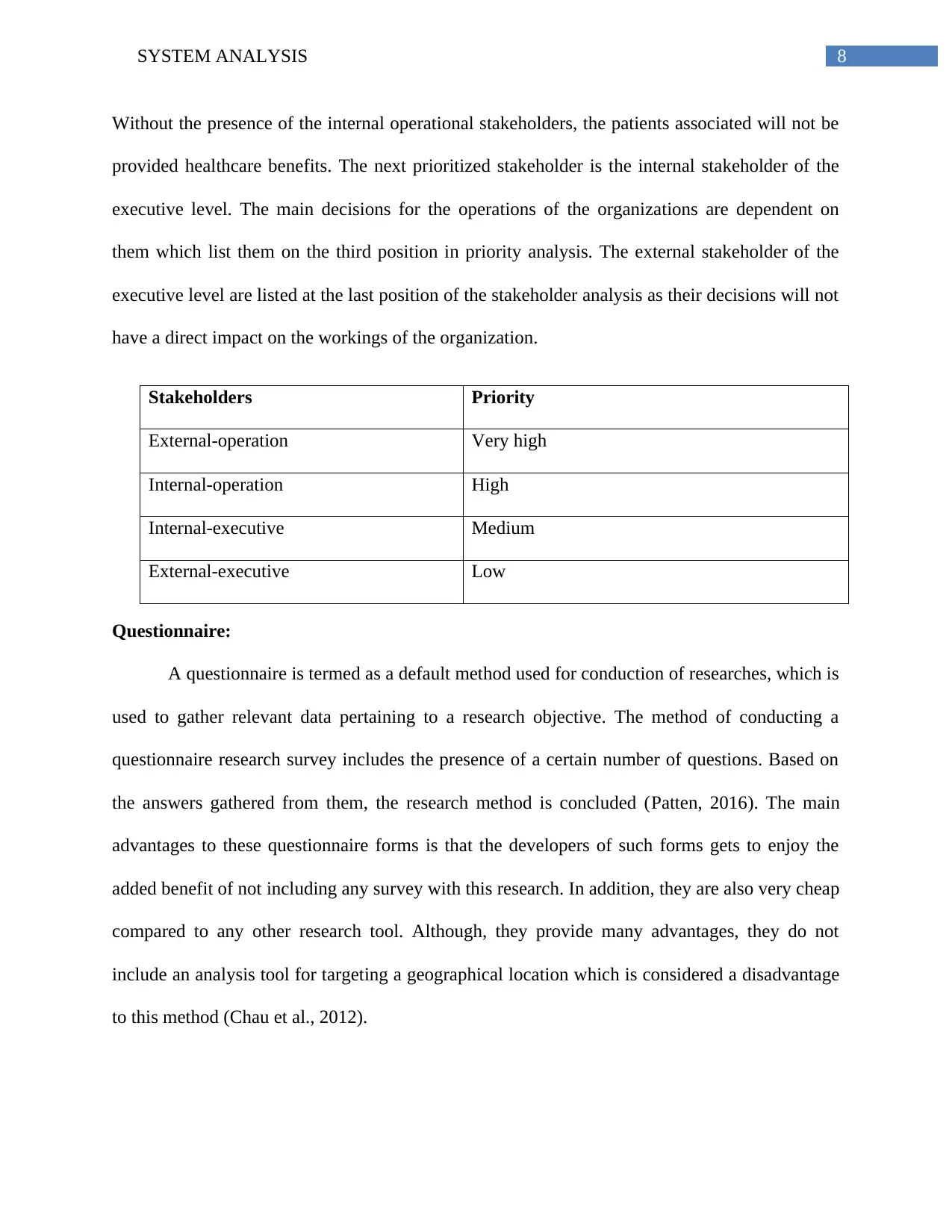
8SYSTEM ANALYSIS
Without the presence of the internal operational stakeholders, the patients associated will not be
provided healthcare benefits. The next prioritized stakeholder is the internal stakeholder of the
executive level. The main decisions for the operations of the organizations are dependent on
them which list them on the third position in priority analysis. The external stakeholder of the
executive level are listed at the last position of the stakeholder analysis as their decisions will not
have a direct impact on the workings of the organization.
Stakeholders Priority
External-operation Very high
Internal-operation High
Internal-executive Medium
External-executive Low
Questionnaire:
A questionnaire is termed as a default method used for conduction of researches, which is
used to gather relevant data pertaining to a research objective. The method of conducting a
questionnaire research survey includes the presence of a certain number of questions. Based on
the answers gathered from them, the research method is concluded (Patten, 2016). The main
advantages to these questionnaire forms is that the developers of such forms gets to enjoy the
added benefit of not including any survey with this research. In addition, they are also very cheap
compared to any other research tool. Although, they provide many advantages, they do not
include an analysis tool for targeting a geographical location which is considered a disadvantage
to this method (Chau et al., 2012).
Without the presence of the internal operational stakeholders, the patients associated will not be
provided healthcare benefits. The next prioritized stakeholder is the internal stakeholder of the
executive level. The main decisions for the operations of the organizations are dependent on
them which list them on the third position in priority analysis. The external stakeholder of the
executive level are listed at the last position of the stakeholder analysis as their decisions will not
have a direct impact on the workings of the organization.
Stakeholders Priority
External-operation Very high
Internal-operation High
Internal-executive Medium
External-executive Low
Questionnaire:
A questionnaire is termed as a default method used for conduction of researches, which is
used to gather relevant data pertaining to a research objective. The method of conducting a
questionnaire research survey includes the presence of a certain number of questions. Based on
the answers gathered from them, the research method is concluded (Patten, 2016). The main
advantages to these questionnaire forms is that the developers of such forms gets to enjoy the
added benefit of not including any survey with this research. In addition, they are also very cheap
compared to any other research tool. Although, they provide many advantages, they do not
include an analysis tool for targeting a geographical location which is considered a disadvantage
to this method (Chau et al., 2012).
⊘ This is a preview!⊘
Do you want full access?
Subscribe today to unlock all pages.

Trusted by 1+ million students worldwide
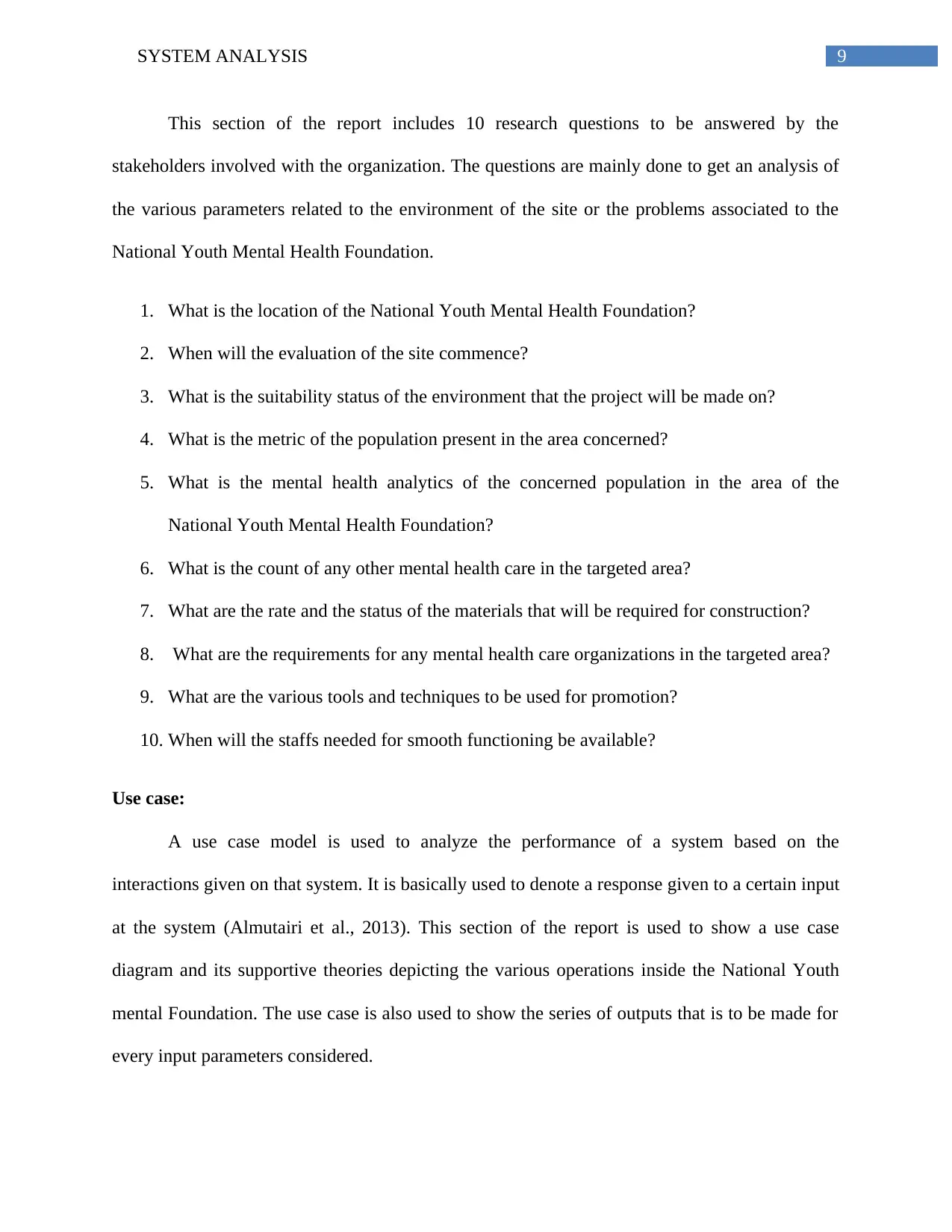
9SYSTEM ANALYSIS
This section of the report includes 10 research questions to be answered by the
stakeholders involved with the organization. The questions are mainly done to get an analysis of
the various parameters related to the environment of the site or the problems associated to the
National Youth Mental Health Foundation.
1. What is the location of the National Youth Mental Health Foundation?
2. When will the evaluation of the site commence?
3. What is the suitability status of the environment that the project will be made on?
4. What is the metric of the population present in the area concerned?
5. What is the mental health analytics of the concerned population in the area of the
National Youth Mental Health Foundation?
6. What is the count of any other mental health care in the targeted area?
7. What are the rate and the status of the materials that will be required for construction?
8. What are the requirements for any mental health care organizations in the targeted area?
9. What are the various tools and techniques to be used for promotion?
10. When will the staffs needed for smooth functioning be available?
Use case:
A use case model is used to analyze the performance of a system based on the
interactions given on that system. It is basically used to denote a response given to a certain input
at the system (Almutairi et al., 2013). This section of the report is used to show a use case
diagram and its supportive theories depicting the various operations inside the National Youth
mental Foundation. The use case is also used to show the series of outputs that is to be made for
every input parameters considered.
This section of the report includes 10 research questions to be answered by the
stakeholders involved with the organization. The questions are mainly done to get an analysis of
the various parameters related to the environment of the site or the problems associated to the
National Youth Mental Health Foundation.
1. What is the location of the National Youth Mental Health Foundation?
2. When will the evaluation of the site commence?
3. What is the suitability status of the environment that the project will be made on?
4. What is the metric of the population present in the area concerned?
5. What is the mental health analytics of the concerned population in the area of the
National Youth Mental Health Foundation?
6. What is the count of any other mental health care in the targeted area?
7. What are the rate and the status of the materials that will be required for construction?
8. What are the requirements for any mental health care organizations in the targeted area?
9. What are the various tools and techniques to be used for promotion?
10. When will the staffs needed for smooth functioning be available?
Use case:
A use case model is used to analyze the performance of a system based on the
interactions given on that system. It is basically used to denote a response given to a certain input
at the system (Almutairi et al., 2013). This section of the report is used to show a use case
diagram and its supportive theories depicting the various operations inside the National Youth
mental Foundation. The use case is also used to show the series of outputs that is to be made for
every input parameters considered.
Paraphrase This Document
Need a fresh take? Get an instant paraphrase of this document with our AI Paraphraser
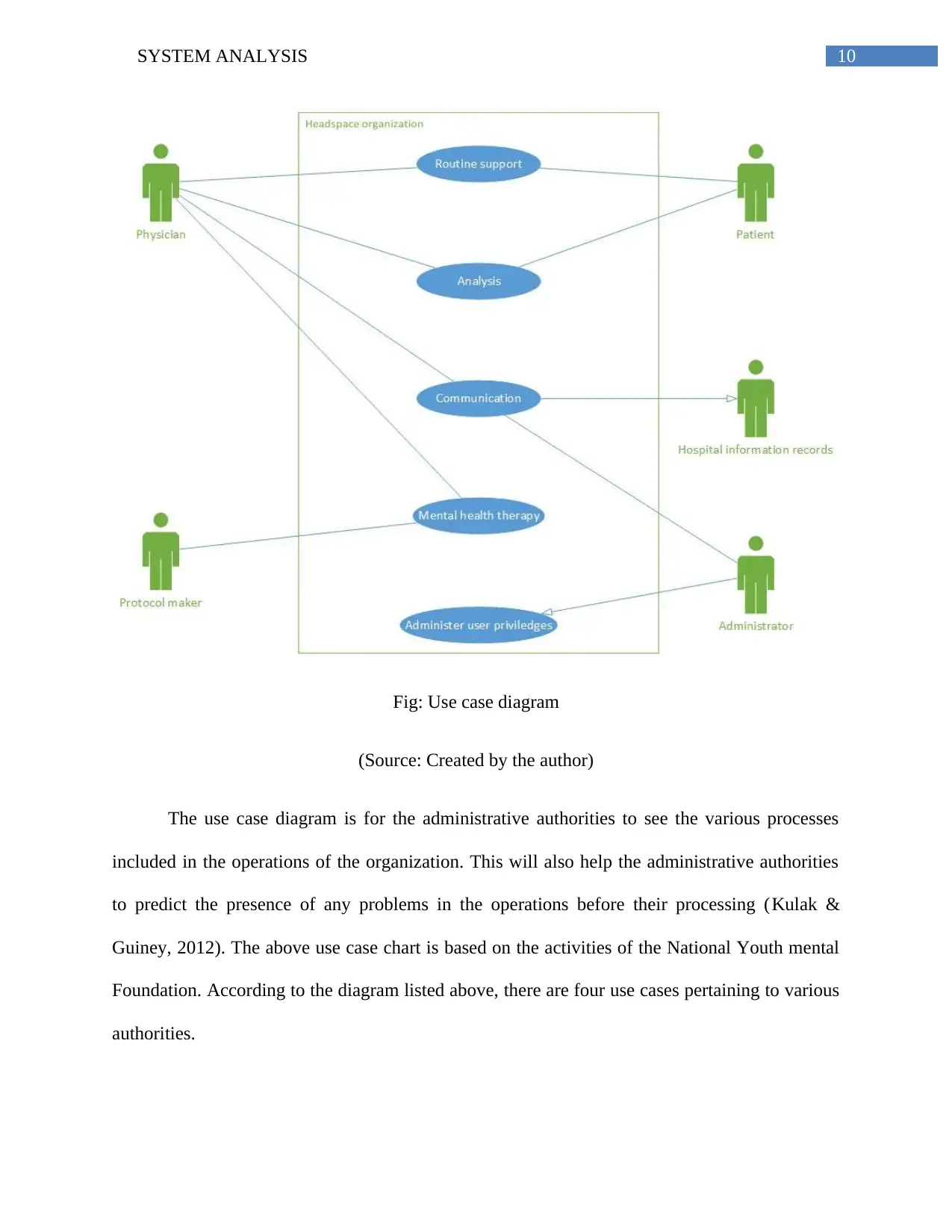
10SYSTEM ANALYSIS
Fig: Use case diagram
(Source: Created by the author)
The use case diagram is for the administrative authorities to see the various processes
included in the operations of the organization. This will also help the administrative authorities
to predict the presence of any problems in the operations before their processing (Kulak &
Guiney, 2012). The above use case chart is based on the activities of the National Youth mental
Foundation. According to the diagram listed above, there are four use cases pertaining to various
authorities.
Fig: Use case diagram
(Source: Created by the author)
The use case diagram is for the administrative authorities to see the various processes
included in the operations of the organization. This will also help the administrative authorities
to predict the presence of any problems in the operations before their processing (Kulak &
Guiney, 2012). The above use case chart is based on the activities of the National Youth mental
Foundation. According to the diagram listed above, there are four use cases pertaining to various
authorities.
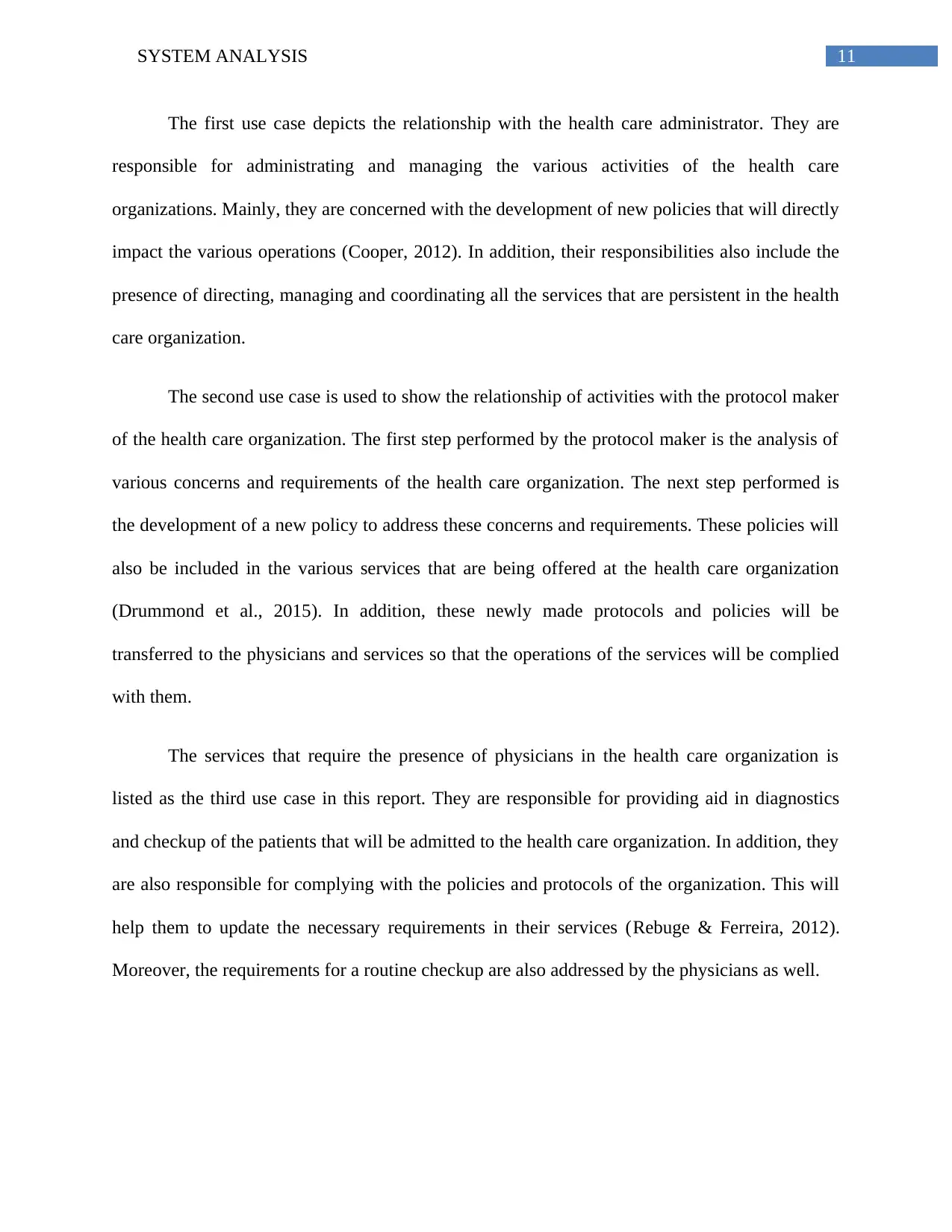
11SYSTEM ANALYSIS
The first use case depicts the relationship with the health care administrator. They are
responsible for administrating and managing the various activities of the health care
organizations. Mainly, they are concerned with the development of new policies that will directly
impact the various operations (Cooper, 2012). In addition, their responsibilities also include the
presence of directing, managing and coordinating all the services that are persistent in the health
care organization.
The second use case is used to show the relationship of activities with the protocol maker
of the health care organization. The first step performed by the protocol maker is the analysis of
various concerns and requirements of the health care organization. The next step performed is
the development of a new policy to address these concerns and requirements. These policies will
also be included in the various services that are being offered at the health care organization
(Drummond et al., 2015). In addition, these newly made protocols and policies will be
transferred to the physicians and services so that the operations of the services will be complied
with them.
The services that require the presence of physicians in the health care organization is
listed as the third use case in this report. They are responsible for providing aid in diagnostics
and checkup of the patients that will be admitted to the health care organization. In addition, they
are also responsible for complying with the policies and protocols of the organization. This will
help them to update the necessary requirements in their services (Rebuge & Ferreira, 2012).
Moreover, the requirements for a routine checkup are also addressed by the physicians as well.
The first use case depicts the relationship with the health care administrator. They are
responsible for administrating and managing the various activities of the health care
organizations. Mainly, they are concerned with the development of new policies that will directly
impact the various operations (Cooper, 2012). In addition, their responsibilities also include the
presence of directing, managing and coordinating all the services that are persistent in the health
care organization.
The second use case is used to show the relationship of activities with the protocol maker
of the health care organization. The first step performed by the protocol maker is the analysis of
various concerns and requirements of the health care organization. The next step performed is
the development of a new policy to address these concerns and requirements. These policies will
also be included in the various services that are being offered at the health care organization
(Drummond et al., 2015). In addition, these newly made protocols and policies will be
transferred to the physicians and services so that the operations of the services will be complied
with them.
The services that require the presence of physicians in the health care organization is
listed as the third use case in this report. They are responsible for providing aid in diagnostics
and checkup of the patients that will be admitted to the health care organization. In addition, they
are also responsible for complying with the policies and protocols of the organization. This will
help them to update the necessary requirements in their services (Rebuge & Ferreira, 2012).
Moreover, the requirements for a routine checkup are also addressed by the physicians as well.
⊘ This is a preview!⊘
Do you want full access?
Subscribe today to unlock all pages.

Trusted by 1+ million students worldwide
1 out of 18
Related Documents
Your All-in-One AI-Powered Toolkit for Academic Success.
+13062052269
info@desklib.com
Available 24*7 on WhatsApp / Email
![[object Object]](/_next/static/media/star-bottom.7253800d.svg)
Unlock your academic potential
Copyright © 2020–2025 A2Z Services. All Rights Reserved. Developed and managed by ZUCOL.





